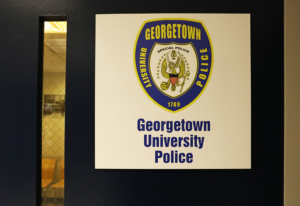More than two months after a string of anti-Semitic vandalism incidents in two residence halls shook campus, the Georgetown University Police Department has not identified a suspect.
Swastikas were found painted in an LXR Hall elevator and bathroom on at least three occasions in September shortly after a swastika was carved into an elevator of Village C West. GUPD increased security and installed cameras around LXR in response to the vandalism.

After more than two months, the Georgetown University Police Department has not identified a suspect in a string of anti-Semitic vandalisms.
GUPD Police Chief Jay Gruber said campus police have conducted extensive investigations and interviews to identify the person responsible, but the investigation is ongoing.
Jessica Keller (COL ’20), president of J Street U Georgetown, a pro-Israel campus group, said that the administration should have taken stronger action against the anti-Semitic sentiment on campus.
“The administration should do more to forcibly condemn the incidences of anti-Semitism that continue to plague our campus. It appears that actions of anti-Semitism and misogyny have only been bolstered by the inability of our society to condemn this hateful rhetoric, and I believe that more must be done, both by the administration and by other student organizations, to combat this threat,” Keller wrote in an email to The Hoya.
Rev. Mark Bosco, S.J., vice president for mission and ministry, and Todd Olson, vice president for student affairs, sent a campuswide email in response to the swastikas found carved in VCW, and University President John J. DeGioia sent another campuswide email in response to the swastikas found painted in LXR.
The emails condemned the acts of vandalism and promised those responsible would be held accountable for their actions.
Keller said although the university could do more, she appreciates its responses to the acts of vandalism.
“The administration’s efforts to vocalize their condemnation of anti-Semitism and efforts to stand alongside the Jewish community (i.e. attending Shabbat services in solidarity) went a long way in reassuring our Jewish student community that their safety and sense of community on campus are university priorities,” Keller wrote.
Tanner Larkin (SFS ’20), vice president of the Georgetown Israel Alliance, said the university addressed the anti-Semitic vandalism well but should have continued its campuswide updates to maintain Georgetown’s awareness of anti-Semitism on campus. The university initially sent campuswide announcements after each incident but stopped in September after incidents accelerated, apparently in response to widespread attention.
“Once students, faculty, and alumni stopped hearing about the swastikas, they wrongly assumed they had stopped appearing,” Larkin wrote in an email to The Hoya.
Larkin said the swastikas drawn in dorms reflect a larger problem with anti-Semitism on campus.
“It is important that people recognize that anti-Semitism is a bigger problem than just some graffiti. Swastikas are only the most glaring kind of anti-Semitism at Georgetown,” Larkin said.
Hasaan Munim (SFS ’18), president of the Georgetown University Muslim Students Association, said the Muslim community stood in solidarity with Jewish students at Georgetown and strove to provide support by attending Shabbat services and co-hosting interfaith dialogues.
“The immediate reaction was to look for ways to support members of the Georgetown community who are Jewish,” Munim said.
Georgetown University Student Association Press Secretary Aaron Bennett (COL ’19) said that GUSA condemns acts of hate such as the anti-Semitic vandalism and continues to support Jewish students at Georgetown.
“GUSA holds firm that hate is not welcome at Georgetown, and we stand in solidarity with members of our Jewish community, as well as all other communities on our campus affected by these incidents,” Bennett wrote in an email to The Hoya.
Since the first swastikas appeared in VCW and LXR, many groups at Georgetown have organized events to raise awareness about anti-Semitism on campus and provide spaces for conversations around diversity and inclusion on campus. GUSA partnered with the Office of Institutional Diversity, Equity and Affirmative Action to organize a lunch event called “Fostering and Promoting Interreligious Dialogue” on Nov. 2, according to Bennett.
GUSA, J Street U, the Jewish Student Association and other Jewish student groups on campus organized a “What’s a Hoya” event to discuss anti-Semitism at Georgetown. JSA President Claire Goldberg (COL ’19) said the group intends to continue spreading awareness about anti-Semitism at Georgetown.
Nash Hale (COL ’20), a resident of LXR, said many people in the dorm have moved on from the anti-Semitic vandalism.
“At this point, it’s been a few months since the last swastika. Everyone has moved on and put those events in the past,” Hale wrote in an email to The Hoya.




















